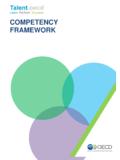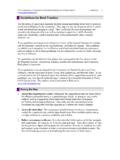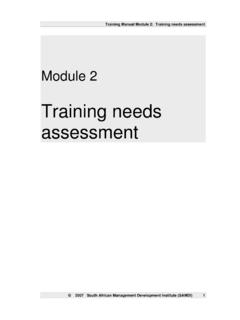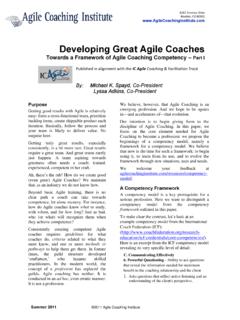Transcription of Fostering Quality Teaching in Higher Education: …
1 IMHEI nstitutional Management in Higher Quality Teaching in Higher Education: Policies and PracticesAn IMHE Guide for Higher education Institutions September 2012 Fabrice H nard and Deborah Roseveare 2 3 Foreword Quality Teaching in Higher education matters for student learning outcomes. But Fostering Quality Teaching presents Higher education institutions with a range of challenges at a time when the Higher education sector is coming under pressure from many different directions. Institutions need to ensure that the education they offer meets the expectations of students and the requirements of employers, both today and for the future. Yet Higher education institutions are complex organisations where the institution-wide vision and strategy needs to be well-aligned with bottom-up practices and innovations in Teaching and learning. Developing institutions as effective learning communities where excellent pedagogical practices are developed and shared also requires leadership, collaboration and ways to address tensions between innovators and those reluctant to change.
2 This Guide has been developed by the OECD s Programme on Institutional Management of Higher education (IMHE) to assist Higher education institutions, university leaders and practitioners in Fostering Quality Teaching . Provosts, vice-rectors of academic affairs, heads of Teaching and learning improvement centres, deans and programme leaders, supporting staff, members of internal and external Quality assurance bodies, and researchers may find inspirational content in this report. Drawing upon case studies of institution-wide Quality Teaching policies conducted by the OECD, this Guide provides exposure to new approaches and practices and the corresponding policy levers likely to help improvement happen. Illustrations offer a unique opportunity for learning through international experiences and sharing insights with institutional leaders involved in Quality Teaching .
3 4 Acknowledgements This IMHE Guide would not have been possible without the substantial input from many different contributors. First and foremost, these include the participating institutions and their leaders, teachers, students and stakeholders, without whom there would have been no relevant examples to draw on. Each one of these institutions has demonstrated their commitment to Fostering Quality Teaching throughout their participation in this project. We are also grateful to the academics from those institutions, who prepared the examples that are included in this Guide. The academic experts participating in this project have also played a crucial role through their invaluable contributions and constant support since the inception of this project, namely, Alenoush Saroyan (McGill University), George Gordon (Strathclyde University), Frank MacMahon (Dublin Institute of Technology), Fernando Leon Garcia (CETYS University), Ray Land (Durham University), Gabor Halasz (E tv s Lor nd University), Guls n Saglamer (Istanbul Technical University), Outi Kallioinen (Lahti University of Applied Sciences), Denis Berthiaume (Universit de Lausanne).
4 Special thanks are due to Imma Tubella, President of UOC and Fernando Leon Garcia, Rector of CETYS and President of CONAHEC, who co-organised seminars and conferences with the OECD that enabled the OECD, the experts, the teachers, students and researchers to exchange experience about Quality Teaching across the world. Finally, we wish to acknowledge the help and support of the many colleagues in the Directorate for education of the OECD who have contributed to this project and publication and in particular, Richard Yelland in his former role as head of the IMHE Programme. 5 Table of contents Foreword .. 3 Acknowledgements .. 4 Table of contents .. 5 What is Quality Teaching and why does it matter? .. 7 Policy lever 1. Raising awareness of Quality Teaching .. 13 Policy lever 2. Developing excellent teachers .. 17 Policy lever 3. Engaging students .. 21 Policy lever 4. Building organisation for change and Teaching 25 Policy lever 5.
5 Aligning institutional policies to foster Quality Teaching .. 29 Policy lever 6. Highlighting innovation as a driver for change .. 33 Policy lever 7. Assessing impacts .. 37 Self-assessment and questions for further reflection .. 41 References and further reading .. 49 More about the Quality Teaching Project .. 51 More about 53 6 7 What is Quality Teaching and why does it matter ? Quality Teaching is the use of pedagogical techniques to produce learning outcomes for students. It involves several dimensions, including the effective design of curriculum and course content, a variety of learning contexts (including guided independent study, project-based learning, collaborative learning, experimentation, etc.), soliciting and using feedback, and effective assessment of learning outcomes. It also involves well-adapted learning environments and student support services. Experience showed that Fostering Quality Teaching is a multi-level endeavour.
6 Support for Quality Teaching takes place at three inter-dependent levels: At the institution-wide level: including projects such as policy design, and support to organisation and internal Quality assurance systems. Programme level: comprising actions to measure and enhance the design, content and delivery of the programmes within a department or a school. Individual level: including initiatives that help teachers achieve their mission, encouraging them to innovate and to support improvements to student learning and adopt a learner-oriented focus. These three levels are essential and inter-dependent. However, supporting Quality Teaching at the programme level is key so as to ensure improvement in Quality Teaching at the discipline level and across the institution. Support for Quality Teaching can be manifested through a wide range of activities that are likely to improve the Quality of the Teaching process, of the programme content, as well as the learning conditions of students.
7 Hybrid forms often prevail in institutions. These can include initiatives such as: A centre for Teaching and learning development Professional development activities ( in-service training for faculty) Teaching excellence awards and competitions for remarkable improvements Teaching innovation funds Teaching recruitment criteria Support to innovative pedagogy Communities of Teaching and learning practices Learning environments (libraries, computing ) Organisation and management of Teaching and learning Support to foster student achievement ( counselling, career advice, ) Students evaluation ( programme ratings, evaluating learning experiences) Self-evaluation of experimentations, peer-reviewing, benchmarking of practices Community service and work-based programmes, development-based programmes Competence-based assessments A number of factors have brought Quality Teaching to the forefront of Higher education policies.
8 Almost every education system has experienced substantial growth of student numbers in recent decades and the student profile has become more diverse. At the same time, Higher education faces greater from students, parents, employers and taxpayers to account for their performance and demonstrate their Teaching Quality . 8 Institutions engage in Fostering Quality Teaching essentially for the following reasons: To respond to the growing demand for meaningful and relevant Teaching . Students as well as employers want to ensure that their education will lead to gainful employment and will equip them with the skills needed to evolve professionally over a lifetime. To demonstrate that they are reliable providers of good Quality Higher education , while operating in a complex setting, with multiple stakeholders, each with their own expectations (ministries, funding agencies, local authorities, ).
9 To balance performance on Teaching and learning achievements along with research performance, since even for elite, world-class universities, research performance is no longer sufficient to maintain the reputation of the institution. To more effectively compete for students against the backdrop of Higher tuition fees and greater student mobility. To increase the efficiency of the Teaching and learning process as funding constraints become more stringent. Teaching Quality throughout the world is also influenced by contextual shifts within the Higher - education environment. Current factors influencing the Quality of Teaching include: the internationalisation of Higher education the increasingly broadening scope of education and greater diversity of student profiles the rapid changes in technology, which can quickly make programme content and pedagogies obsolete the demand for greater civic engagement of graduates and regional development of Higher education the increased pressures of global competition, economic efficiency the need to produce a skilled workforce to meet the challenges of the 21st century New paradigms for Quality Teaching The fundamental changes in employment over the past 50 years imply a rise in the demand for non-routine cognitive and interpersonal skills and a decline in the demand for routine cognitive and craft skills, physical labour and repetitive physical tasks (OECD, 2012).
10 Graduates are entering a world of employment that is characterised by greater uncertainty, speed, risk, complexity and interdisciplinary working. University education , and the mode of learning whilst at university, will need to prepare students for entry to such an environment and equip them with appropriate skills, knowledge, values and attributes to thrive in it. There is a strong drive to build and create knowledge together with an understanding of working life and reformulate the concept of knowledge in learning situations. Tighter connections with working life through different academic projects provide authentic opportunities to learn both generic and professional competencies as well as to build networks and pathways for employment after graduation. Universities across the globe are increasingly pressed to find ways of proving their worth not only in the preparation of students, but also how they are linked to business and industry.
















